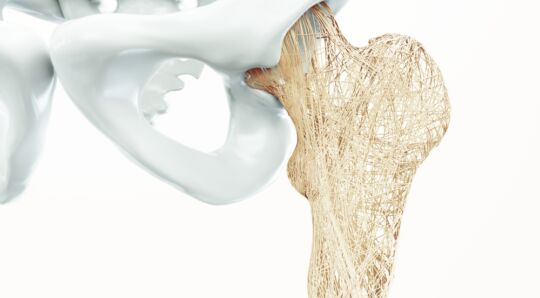Key points
- Identify and treat patients with minimal trauma fracture. Many people who sustain a minimal trauma fracture are treated for the fracture and not the underlying osteoporosis.
- Identify patients with other risk-factors for osteoporotic fracture. Consider factors in addition to bone mineral density (BMD) and age.
- Discuss the risks and implications of osteoporotic fractures with these patients and approaches to reduce these risks.
- Use bone densitometry and laboratory tests to assess severity of osteoporosis.
- Medicines for osteoporosis vary markedly: consider effectiveness, tolerability, co-morbidities, and patient preferences when choosing therapy.
- Poor adherence to osteoporosis treatment is a leading cause of fractures and hospitalisations. Review therapies regularly for adherence and treatment response.
MedicineWise News: Recognising those at risk

Osteoporosis is under-recognised and undertreated, even in people who present with minimal trauma fractures.
Australian Prescriber: Bone mineral density: testing for osteoporosis

Angela Sheu and Terry Diamond
Aust Prescr 2016;39:35-91 Apr 2016
A thoracolumbar X-ray is useful in identifying vertebral fractures, and dual energy X-ray absorptiometry is the preferred method of calculating bone mineral density.
Background feature: Why osteoporosis matters

General practice can play an important role in preventing the health burden associated with osteoporosis through timely diagnosis and management to prevent osteoporotic fractures.
Find out why osteoporosis matters and what we need to do to address gaps in practice.
Osteoporosis in aged care

Osteoporosis is increasingly prevalent in an aging population and may affect a large proportion of aged care residents. Bone health assessment, falls prevention measures and regular medicine review can go a long way towards avoiding the pain, disability and mortality caused by fractures.
Get the detailed practice points for osteoporosis treatment in aged care.
Osteoporosis is not just a women's disease

In men, minimal trauma fractures due to osteoporosis result in higher mortality rates compared with women. Despite this, treatment uptake in men is low, with 90% of men eligible for osteoporosis medicines remaining untreated.
Evaluation: GP survey results for Osteoporosis program
We surveyed GPs who participated in the visiting program 'Preventing fractures: where to start with osteoporosis' to find out what they learned and whether they thought it was worthwhile.
CPD
Consolidate your knowledge about osteoporosis, brush up on current guidelines and practices and earn CPD points through our learning activities.
For GPs:
For pharmacists:
For nurses:
Clinical resources and tools
- Osteoporosis prevention, diagnosis and management in postmenopausal women and men over 50 years of age. 2nd edition. 2017
- Scottish Intercollegiate Guidelines Network, Management of osteoporosis and the prevention of fragility fractures, 2015 (updated 2021)
- WHO Collaborating Centre for Metabolic Bone Diseases, FRAX Fracture Risk Assessment Tool
For your patients
Research summary
Clinical guidelines
| Guidelines | Results / Recommendations |
|---|---|
| Royal Australian College of General Practitioners. Osteoporosis prevention, diagnosis and management in postmenopausal women and men over 50 years of age. 2nd edition. Melbourne: RACGP, 2017. | Clinical guideline for the prevention and treatment of osteoporosis in postmenopausal women and older men. This guideline reviews the pharmacological management of osteoporosis to May 2009. Check the RACGP website for any reviews or updates of this guideline. |
| Royal Australian College of General Practitioners. Guidelines for preventive activities in general practice. 9th ed. East Melbourne, Vic: RACGP, 2016. | General practice guidance on preventive care. It includes primary and secondary (early detection and intervention) prevention activities for osteoporosis. |
| Osteoporosis Australia. Building healthy bones throughout life: An evidence-informed strategy to prevent osteoporosis in Australia. MJA Open 2013 2, Suppl 1. | An evidence-informed strategy to prevent osteoporosis in Australia, including age-based recommendations for calcium, vitamin D and exercise and information on falls prevention. |
| SIGN. Guideline No. 142: Management of osteoporosis and the prevention of fragility. Edinburgh: SIGN, 2015 (updated 2021). | This evidence-based guideline on the management of osteoporosis and prevention of fractures. It covers risk factors for fracture, tools for assessment of fracture risk, pharmacological, and non-pharmacological treatments, treatment of painful vertebral fractures and systems of care. |
| Therapeutic Guidelines. Bone and metabolism. Melbourne: Therapeutic Guidelines Ltd, 2019. | The most current and comprehensive of the Australian guidelines on osteoporosis, covering diagnosis, risk factors, prevention and treatment. |
Fracture risk assessment
| Reference | Results / Recommendations |
|---|---|
| Kanis JA, Johnell O, Oden A, et al. FRAX and the assessment of fracture probability in men and women from the UK. Osteoporos Int 2008;19:385-97 | Describes development of a fracture risk assessment tool (FRAX) to predict 10-year fracture risk in men and women, based on clinical risk factors with or without BMD measurement. The clinical risk factors, identified from previous meta-analyses comprised BMI, prior history of fracture, parental history of hip fracture, use of oral glucocorticoids, rheumatoid arthritis, current smoking and alcohol intake ≥ 3 daily |
Fracture, refracture and mortality
| Reference | Results / Recommendations |
|---|---|
| Bliuc D, Nguyen ND, Nguyen TV, et al. Compound risk of high mortality following osteoporotic fracture and re-fracture in elderly women and men. J Bone Miner Res 2013 | Study of the long-term cumulative incidence of subsequent fracture and total mortality in community dwelling participants aged 60+ years from the Dubbo Osteoporosis Epidemiology Study. It found:
|
Medication and adherence
| Reference | Results / Recommendations |
|---|---|
| Australian Institute of Health and Welfare. Use of antiresorptive agents for osteoporosis management. Canberra: AIHW, 2011 | A report on the supply pattern of antiresorptive agents (primarily alendronate and risedronate) for management of osteoporosis in Australia during 2003–07.
This found:
|

